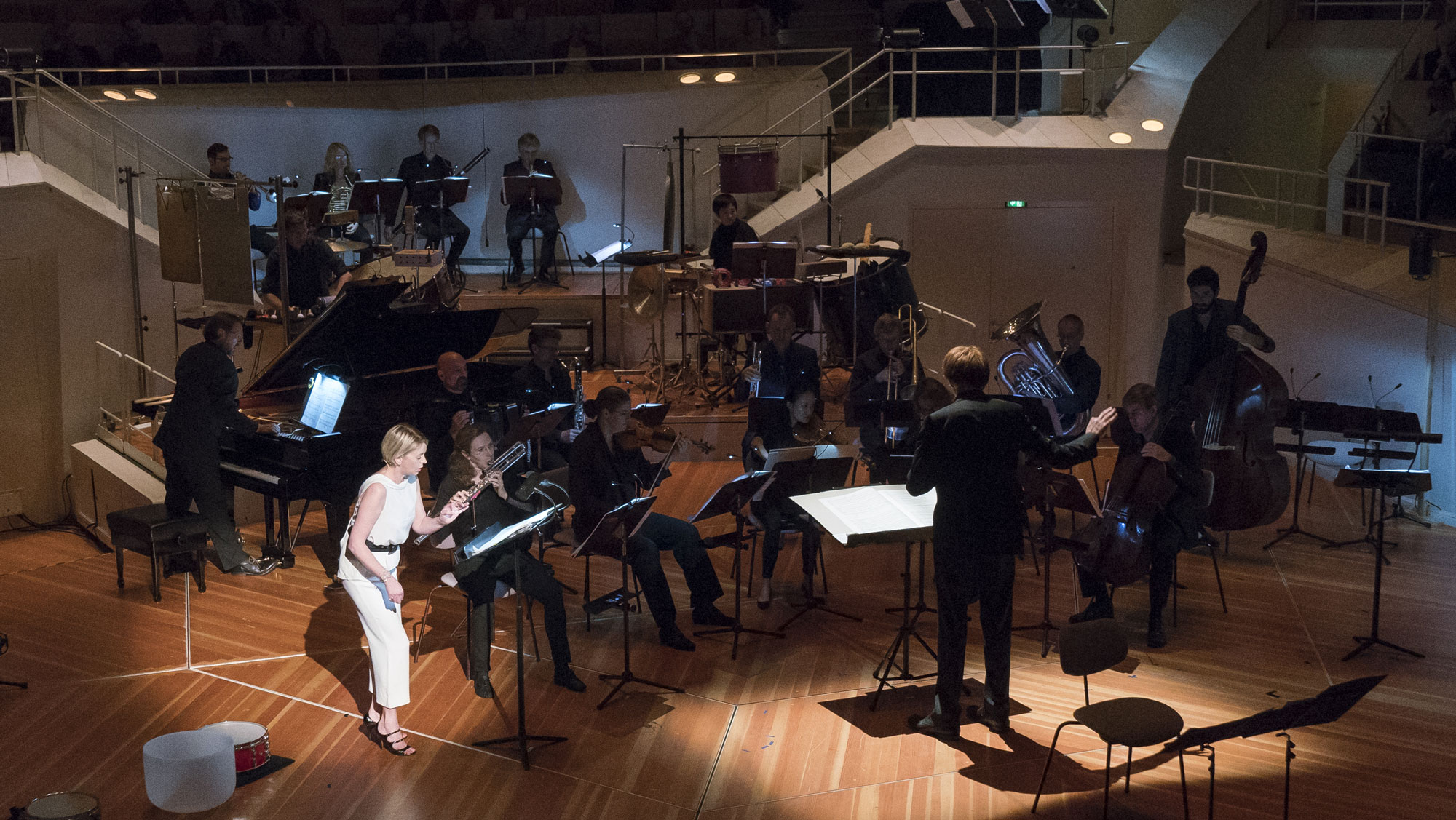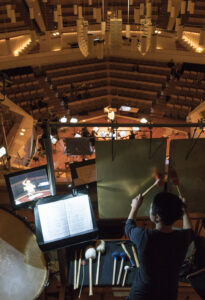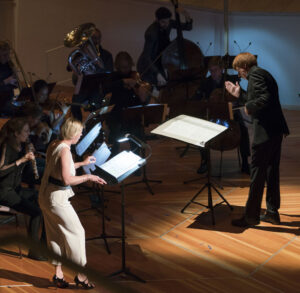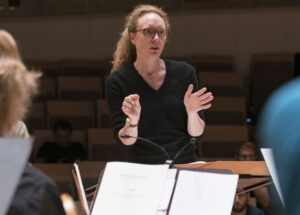
Yes
Rebecca Saunders
Yes refers to Molly Bloom’s monologue, the final chapter of James Joyce’s Ulysses. This monologue can be regarded as a kind of literary collage, a web woven from the innumerable paths traced by stories, thoughts, associations, and moments in a continuous, unrelenting high-energy stream: a snapshot, a state of being before and during the act of falling asleep, amid glimmerings of the subconscious.
Oscillating between moments of absence and presence, the text is not always audible, remaining often subcutaneous, yet still tangible and present. The monologue is often sung, but also recited by the soprano and the instrumental musicians, be it on an out- or in-breath, half-whispered, nearly silent, or suppressed beneath a hand. At times words or phrases rear up, becoming visible, audible and intelligible, before disappearing again, consumed within the flow of the music – just as moments of Bloom’s biography, personality, and memories take on temporary form in her inner, stream-of-consciousness monologue, only to sink back into the river of time.
Working with the voice, its limits, and the need of breath can capture an innate human fallibility, a raw intimacy – and exploring a multitude of ways to work with the breath opened up a whole new world of sonic and emotional possibilities. The various forms of recitation of the text seek partly to suppress and transform the monologue into a multitude of a sonic surfaces, which the music then implies, suggests, frames and re-contextualises. While Yes eschews any immediacy of meaning, its juxtaposition of words and music seeks to unleash meaningful, emotionally charged relationships from within the text.
The repeated ‘yes’ is ambiguous and complex. It casts shadows of and allusions to: the moment of half-conscious orgasm; a life-affirming ‘yes’; the ‘yes’ that seals one’s fate; and Bloom’s recollections of myriad sexual encounters. These deeply erotic moments – in all their facets, from romantic to soberingly grotesque – appear in the music in a variety of shadings, which overlap and coalesce. Yes closely explores the monologue’s most explicit passages – specifically intending to rebuke any coy, clichéd interpretation of Molly Bloom – plumbing the fathomless depths of Joyce’s text, with its unleashing of a raw sexual energy that refuses narrow definitions of sex and gender.
A singer stands silently on the stage – a theatrical moment in itself. The human body – our anticipation of it, of every movement of the eyes, the corners of the mouth – therein lies infinite dramatic potential. In Yes, both soprano and instrumentalists are viewed as protagonists in a quasi-abstract theater, co-existing in a shared sonic landscape. The 28 separately composed soli, chamber-music works, and ensemble pieces – the modules – are distributed throughout the space, and are collaged in a spatial and musical polyphony.
Almost every module represents, with exhaustive insistence, an immutable state, always in essence the same. Fragments, each time slightly varied, gradually create a single image or ‘object’: imprints reiterated and projected into time and space, like a giant mobile seen from many perspectives, that in itself remains untouched. The light, the focus, and the position from which it is perceived are altered, as is our nearness and distance to the object – a manifest complex protraction of the one, singular thing.
Yes explores a music which steps out of the flow of time, which is projected into space like a sound sculpture – and which, at the moment of listening, seeks absolute focus on the physical presence of the sound.
Rebecca Saunders, 2017



Dates
The worldpremiere of Yes took place on Sep 9th 2017 at Musikfest at Berliner Philharmonie.
The French premiere took place on Sep 28th 2017 at Festival d’automne à Paris.
The British premiere took place on 16.11.2018 at the opening concert of Huddersfield Contemporary Music Festival at Huddersfield Town Hall.
The Austrian premiere took place on 17.11.2023 at Wien Modern at Wiener Konzerthaus.
further dates
Kunstfestspiele Herrenhausen, Galerie Herrenhausen, Hannover
May 6, 2023 ACHT BRÜCKEN | Musik für Köln
Novembre 24, 2023 Elbphilharmonie, Hamburg
Press quotes
Oddly hoarse sounds, often from a falsetto bass flute or bass clarinet. A muted trumpet laying itself over them like a veneer, the thumping of a big drum sounding forth from a far corner of the room. Even more frequently, in this performance, sounds that are nearly impossible to locate. Where are they coming from, which instruments are producing them? The richness of Rebecca Saunders’s sonic vocabulary is overwhelming. And the fact that she developed that vocabulary in collaboration with the ensemble’s musicians definitely contributes to the sound’s beauty. For the musicians, these are personal sounds.
Frankfurter Allgemeine Zeitung, Sept. 11, 2017
Rebecca Saunders opens up a broad and expressive spectrum, without taking out any loans from the familiar rituals of espressivo. The enormously inventive, original, and masterfully realized vision, partly conducted by Enno Poppe, was … extremely well received by the audience.
Berliner Zeitung, Sept. 11, 2017
When the soprano and instrumentalists fan out across the stage and into the house, impressive spatial-sound effects are created, especially in the second half.
Der Tagesspiegel, Sept. 11, 2017
Saunders works intensively both on individual tones and with the sound quality of the different instruments: The tones produced by one are taken up by others, absorbed by them, so that the specific source producing the sound disappears behind the sound itself.
taz, Sept. 11, 2017
Puis ils se déplacent pendant les soixante-dix minutes que dure l’oeuvre , selon un ballet réglé au cordeau par le chef Enno Poppe, à la tête des musiciens de l’ensemble allemande Musikfabrik, don’t l’imagination sonore est sans limites. […]
Le Figaro, 3.10.2017
Cette approche très physique du son crée un théâtre instrumental hypnotique, sans tomber dans la facilité du happening ou du bricolage. Ou comment retrouver la dimension rituelle de la musique.
Le Figaro, 3.10.2017
Musique dont l’énergie raffinée s’impose comme une immense sculpture sonore tour à tour compacte ou transparente, Yes compte vingt-cinq modules variés répartis dans l’espace résonnant – « presque tous représentent un état immuable, d’une obstination épuisante, continu et toujours identique ».
Anaclase, 28.09.2017
